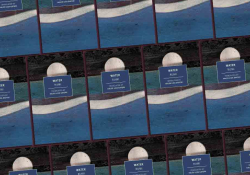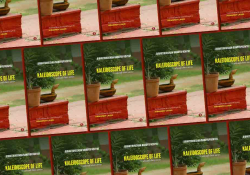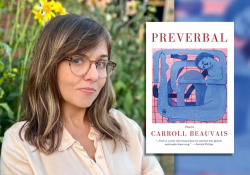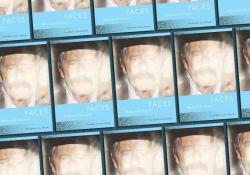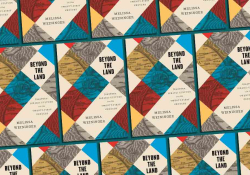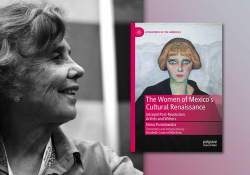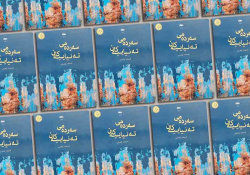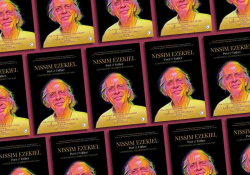Confluently Conversant: Sudeep Sen’s Converse
To read a poem is to hear it with our eyes; to hear it is to see it with our ears.—Octavio Paz
 This quote aptly fits an anthology I came across that goes by the title Converse: Contemporary English Poetry by Indians (Pippa Rann Books & Media, 2022). The 612-page book, edited by Sudeep Sen, celebrates anthology as a genre—what Carl Sandburg called “an echo, asking a shadow to dance.” It is designed for people who aren’t looking for a map of the world with pointers and counsel on it; rather, they are looking for the atmosphere of faraway places that are both new and familiar to anyone whose heart thumps like a city.
This quote aptly fits an anthology I came across that goes by the title Converse: Contemporary English Poetry by Indians (Pippa Rann Books & Media, 2022). The 612-page book, edited by Sudeep Sen, celebrates anthology as a genre—what Carl Sandburg called “an echo, asking a shadow to dance.” It is designed for people who aren’t looking for a map of the world with pointers and counsel on it; rather, they are looking for the atmosphere of faraway places that are both new and familiar to anyone whose heart thumps like a city.
Converse is a compilation of poetry from all around India, making it an itinerary for dreamers and travelers alike to tread on. Sen designs the anthology “to erase the hierarchies and make the boundaries seamless and transparent.” In doing so, he does not bequeath the collection to readers at the mercy of a labyrinth. On the contrary, it offers an escape route at the end of every page. Sen has chosen to arrange the poems following the birth year of the poets, which makes practice and praxis divergent. In his introduction, Sen states that this anthology “celebrates 75 years of India’s Independence.” To look back at the result of the long, gory battle that had resulted from a vindictive pursuit, the echoes of it still remain in bits and pieces in the heart of the poems he has selected for this collection, either directly or indirectly.
The nothingness that is reiterated in “Ash,” by Jayanta Mahapatra, aptly puts forth the illusive peace we seek for:
Even
the view beyond
gives away nothing.
What is the view that brims with the promise of eternity and ephemerality? Are they both rolled in one? Or is the fact that what was once ephemeral now seems eternal or vice versa? The questions are encroached by a postulation, which talks about the illusory pact we find from the sardonic colors to the monochrome:
Over
the illusive wings
of dawn and dusk.
In “Satyagraha in Tübingen,” Madhur Anand sets herself an arduous task—
At the middle of my life I
want that. Directness. More than what my cells make from tides.
On one hand, this might invoke Yuval Noah Harari’s famous statement about how biological inducement aims to tolerate a wide spectrum of possibilities. In contrast, culture impels people to realize a series of possibilities while giving a veto to others. However, Anand continues—
The German word for sea is meer and more is Mehr. Residue, residual knowing difference.
Thereafter results a conundrum: while words are inadequate to the endless sea, there remains “the knowing difference,” similar to what Beckett would say: “I can’t go on, I’ll go on.”
Nobody is devoid of threats or hatred. People have learned to live with that, or to be a passive enabler is what seems equally deranging. Subhashini Kaligotla’s “Ghost” echoes the past that lingers and paralyzes the waking mind:
When to leave the windows and doors open and when to seal myself tightly.
Nights are more dangerous than ever. In this city fear rises at six and sets the next morning.
One learns to live with the ghosts or the haunting memory that has gone decrepit and gropes with even more strength. The animosity of the darkness makes us lonely, and the darker it grows, the lonelier we become. Remnants allow one to survey through the “walls” and “favorite hiding places,” yet “the other places” remain unbridled. To “become a murderer” of residues is daunting in itself, as Subhashini puts forth. “What if I told you I’ve become a murderer, of small creatures with petal feet.”
The poem “To Kill Love,” by Danish Husain, is filled with personal and political details, yet on the surface it is ancillary and lapidary,
To kill love you will have to die
Like an actor who dies at the end of every show
Only to be re-skinned the next day in a room green . . .
The economical usage of phrasing is smart and almost mobile. The discordance of life and death restates what Johann Sebastian Bach affirmed: “With age, art and life blend into one.” One might come up with a question: Why did Husain assert “room green” and not greenroom (common in performance arts). Interpreting each poem of its own can bring out varied meanings. For the green might stand for lushness and jubilance, but the bleakness that comes at the end of “every show” does linger, the desire to “kill love” as an act of asportation.
While seeing it as a celebration of the seventy-fifth year of independence, one cannot forgo terms like refugees. One such poem is “Refugee,” where Tenzin Tsundue’s imperative to speak—to “scrubbed and scrubbed on my forehead I found a brash of red pain”—is framed by the politics of anguish: exile, language debarred, identity despoiled:
I have three tongues,
The one that sings
is my mother tongue.
The R on my forehead
between my English and Hindi
the Tibetan tongue reads:
The volatile war ground where the poet chips himself is blighted by hatred, wrecked by hostilities, and eventually commoditized as tourist sites or normalized.
There are poems that evoke the experiences of the reader and the way the city feels. The pulsation of a metropolis can insinuate the loneliness that is more devouring than the seclusion of a hermit in his cave. The heart that is tattered has something to look forward to. Monica Ferrell writes in the poem “Surrender City”:
Every journey a pilgrimage—every citizen
a fellow traveler, matching you in desire
the way two palms fit.
We could read this in our smiles.
In the wake of the Covid-19 pandemic came a backlash of mental health crises. Poets were no exceptions. They chose their creative faculties not to wryly faint unobtrusively but to widen their frontiers. Sen comments, “The year preceding Covid saw an explosion of poetry.” Thereafter he goes on to name a few literary presses that have led the poetry scene with panache, such as Hawakal, Sahitya Akademi, and Aark Arts, to name a few. Even the poets chose the pandemic to reiterate their ideas of desolation, and yearning, thereby stirring out the surfeit of the time they are breathing/living on. Naveen Kishore’s “Silence” is a quintessential example of the same.
On both sides of the scream
a forced silence
The screaming alteration and advancing on the inside and outside seek “a forced silence” that will end the oscillating flux we are in.
A camera has three eyes. One gazes at the object,
One, burrows into the object.
One, inside itself. (“On Photography”)
Ra Sh clicks using a shutter that is both invisible and indivisible from the world it attempts to describe:
The first eye makes eye contact with eye of the object
The second eye touches the eye inside the object
. . . The third eye is the witness a word for such a time.
This constant carving and corroboration hint at a Derridean trace or supplement in language, but for Ra Sh a linguistic aporia lurks in accompaniment with a political response to power.
Yet I’ve always been grateful for poetry collections in all their ephemeral profusion. One cannot say a poetry anthology is akin to a Horatian monumentum aere perennius. Also, can it be specified as a time capsule? Even that is in doubt. Let’s say we accept that anthologies are limited to a time. Considering the human facet it possesses, a series of foibles follows. It might have resulted from several instances, such as a cup of coffee, a social media thread, or emails during the lockdown. Having said that, if one is prepared to accept omissions, idiosyncrasies, and inclusivity embedded in each anthology, then the serendipitous delight of the genre is bound to leave us enchanted.
If one is prepared to accept omissions, idiosyncrasies, and inclusivity embedded in each anthology, then the serendipitous delight of the genre is bound to leave us enchanted.
A dearth of closure about the Unknown rips our mind apart and throws it into a crossroads—waiting only for voices to walk past it. It is not like “the doors of the room / overlap one another,” as Rabindra K Swain puts forth his thought in “The House Is Not for Knowing.” He reinstates “like uncontrollable tears beneath the door,” which delves into the anguish that a house which once stood erect is now dilapidated. Maybe it is not a house in the literal sense but an identity, a tradition, a long-forgotten past. Now in bits and pieces, the kernel of it hovers around us without lifting the veil, almost instilling what Shakti Chattopadhyay said in “Abani, Are You Home?”
It rains all year round here
Clouds graze the skies like cows
Young green grass, keen,
Clasps the door—
“Abani, are you home?” (trans. Bhaswati Ghosh)
Where did it rain? Which place Shakti pointed at remains unknown, almost emanating the odor of a fractured identity left by the relevance of Indian independence or the conception of it in residues.
where books lie like any other piles
say, of sighs with gypsy ancestry.
The gendered aspects of reality are dealt with in a couple of poems. One such poem that stands out is Kiriti Sengupta’s “When God Is a Woman,” where any hideous felony does not linger, but maybe there are people who “visit a whorehouse” to find a momentary respite or comfort. This brings to mind a particular scene from the film Kalpurush, by auteur Buddhadeb Dasgupta. A character called Sumanta languishes in a dysfunctional marriage, and to seek respite, he visits a whorehouse. The moment the harlot steps in, he does not waste any time but asks, “Do you have a roof here? I am very sleepy. I will sleep on the roof.” Maybe a whorehouse has stood witness to love, betrayals, and as a countenance, but neither let them surfeited with the same. The “admirers” of a harlot remain “silent” like the “God,” and an intrinsic question is planted. Does she remain unattended?
In her sinews
hides a hint of soil
from the yard of courtesans.
In “Boudhanath, Kathmandu,” Gayatri Majumdar marries tales of her waywardness as relating to “aging breathless women of Tibet” with the history of this place that follows “no definitive formula or entitlement.” Her writing about the motionless space’s consternation that brims with life is humorous and sad. She ends her poem with these lines:
. . . there are no sermons on hills,
no chapbooks for the little read;
who else should we blame
for the everyday miracles of our flawless lives
In “Memoir,” Vijay Seshadri writes,
Orwell says somewhere that no one ever writes the real story of their life.
The real story of life is the story of its humiliations.
This reeks of the draconian control exerted by every military state over the years. The Orwellian state is always at play, which Seshadri puts forth,
One is accused the innocent.
Once I bowed and prayed to the guilty.
The accuser and accused throb inside the heart of every living soul. Situations induce one to make a choice. Every choice in favor of someone is a downside to someone sitting right across. Yet paths make way to choices, not to face the Hamletian dilemma of to be or not to be, for the righteous and the unfair can both surface. Still, one has to choose at any cost what functions as a deciding factor. Every act restored in the memoir is an act of survival.
Despite such mundanity and disillusionment, hope is planted through these poems. From weaving the book, Sudeep Sen swiftly levels up his game as he writes a poem such as “Hope: Light Leaks”:
Late at night, light leaks—spilling
beyond the door’s rectangle edge —
No matter what, murky exemplars occur when all hell breaks loose with the overpowering darkness. A certain hope spills somewhere from the corner. Sen’s bravura fosters the discernment that the singer-songwriter Leonard Cohen sought: There is a crack in everything; that’s how the light gets in.
Converse: Contemporary English Poetry by Indians may raise a pertinent question: Is this book any good? For the burgeoning sensibility can be evoked through poetry, if not survival. It can be countered by lines from a poem called “Asphodel, That Greeny Flower,” by William Carlos Williams—
It is difficult to get the news from poems,
yet men die every day
for want of what is found there.


